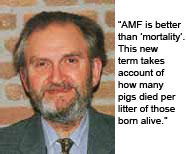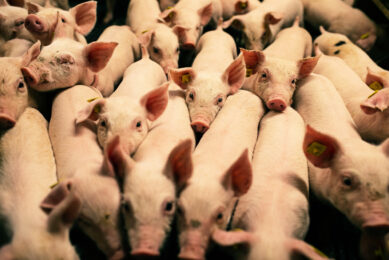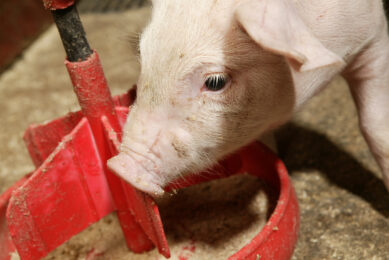What the textbooks don’t tell you about…Percentage mortality

I have been to several conferences and evening meetings recently where the subject of mortality to weaning was hotly debated. This column is not about how to improve things, as the textbooks do this very well. The tenor of the discussions I attended revolved around: “We should be achieving 6% or less mortality of born-alives to weaning, when it seems frustratingly stuck at 12% or more. And this despite better trained staff and improved conditions.”
By John Gadd
Beware of percentages!
We were all taught at school or college – at least I hope we were – “Be aware of percentages – percent of what?” Look at Figure 1, which is an approximation of the mortality scene among the reasonable to better pig producers in the 30 or so countries I have visited in the past 50 years. A radical alteration in the trends has occurred over the past ten years and we need a new assessment of mortality to weaning so as to keep abreast of the praiseworthy success in achieving much bigger litters.
In mortality terms, it is the actual number of piglets we lose, not so much the percentage of those we started with, which is important, although numbers born does have a bearing on the subject. This always has been the case and is even more meaningful now that bigger litters are being secured due to genetics, better-trained staff and improved farrowing house conditions. The following example shows how ‘mortality percentage’ can be misleading.
Looks bad →15% mortality.
If it is of 12 born alives (i.e.1.8 piglets lost) this is 10.2 reared. (12 – 1.8 = 10.2).
Looks good →5% mortality.
If it is of 10.75 born alives (i.e. 0.54 piglets lost) it is also 10.2 reared.
(10.75 – 0.54 = 10.2).
Comment: Certainly it is better only to lose half a pig than nearly two pigs per litter, but the wide differences in mortalities quoted among producers at bench-marking meetings can be misleading as the example clearly shows.
Absolute Mortality Figure (AMF)
A better measurement is AMF. Why? This new term takes account of how many pigs died per litter of those born alive. Not the percentage of those which died per litter, as we don’t know the litter size when a percentage is quoted.
How to express AMF?
I suggest ‘AMF 1.2 12 BA’ (BA = born alive). An average of 1.2 pigs per batch lost from an average batch litter size of 12 born alive. Hopefully this might become familiar as ‘AMF 1.2/12’.
This would be 10% mortality of those born alive. Not that good today, is it!
However, AMF 0.8/12 is only 6.66 % mortality and therefore regarded today as being pretty good, while AMF 0.8/8 is 10% again and not so good at all, even though well under one piglet was lost per litter in both circumstances.
Advantages of AMF compared to mortality percentage
Look at those litter-size figures tacked on to the AMF method of expression. When illustrated like this we can at once see that the problem is not that of mortality which so many get up-tight about – but that of the born-alives, not necessarily the mortality. You will not pick this up immediately from a mortality percentage figure, which because of its limitation ties an important interpretive hand behind your back!
Again, farm recording analysts correctly point out that birthweights have a significant effect on losses to weaning – that is not rocket science and breeders are well aware of this. An AMF figure alerts you to explore the possible influence of birthweights on subsequent deaths to weaning.
Gilts, too. Are their AMFs a lot different from the older sows in the herd? Such differences may need examination, such as time of first service which recent work by JSR Genetics elegantly exposed in advising 135 kg as the most rewarding, i.e. cost effective, liveweight threshold to serve modern gilts in terms of optimal born-alives and therefore favourable AMFs.
No textbook I have read mentions the drawbacks of ‘percent mortality to weaning’. Are the authors right and myself wrong? Maybe, but somehow I don’t feel so. Think about it.











